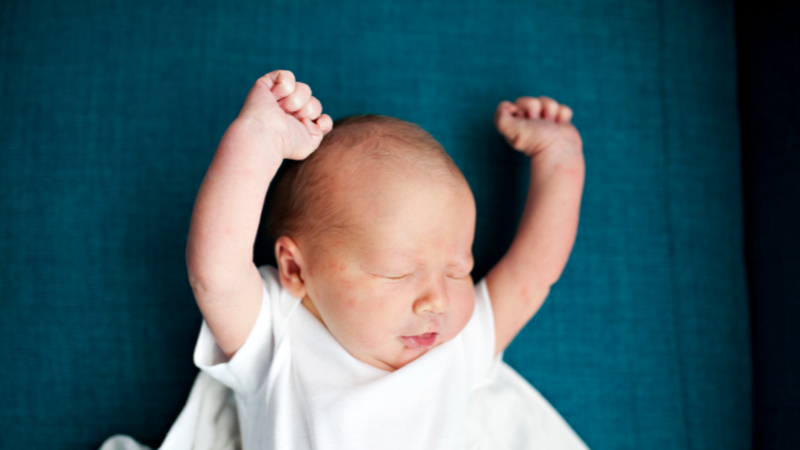In this article
ToggleHave you yawned, blinked, coughed or sneezed today? Those are examples of involuntary movements – or reflexes. Some persist into adulthood but many others disappear within weeks or months of birth.
Or at least, they should! Some children retain primitive reflexes, which may affect their development. Here, we’ll explore the newborn startle reflex. But first, let’s consider why babies have reflexes in the first place…
Why do babies have reflexes?
Newborn babies have limited control over their bodies but they’re born with certain reflexes that help them survive.
Reflexes are involuntary muscle responses to stimulation (movement or sensation). These responses originate in the brainstem and many are present before your baby is born.
At birth, these reflexes help your baby to survive. Key newborn reflexes include the:
- Rooting reflex – when you stroke your baby’s cheek, they turn towards you and open their mouth to feed
- Sucking reflex – your baby starts to suck when there’s a nipple or bottle teat in their mouth
- Stepping reflex – if you hold your baby upright with the soles of their feet touching a flat surface, they will appear to take steps. It’s thought that the stepping reflex may help your baby crawl up to reach the breast after birth.
Doctors, midwives and child health nurses will check your baby’s reflexes regularly as part of normal health assessments. The presence and strength of your baby’s reflexes provide important information about their nervous system.
What is the startle reflex?
The infant startle reflex occurs when your baby is surprised or feels like they’re falling. You may have seen this when you lay your baby in their cot, for example.
When the startle reflex is elicited, your baby will fling their arms out to the side with their hands flexed and their palms upstretched. They may also look quite surprised – and then they may cry!
What can you do if the startle reflex keeps waking up your baby?
Swaddling your baby may help them sleep better if their startle reflex disturbs them when you lay them down in their cot. Swaddling mimics the cosy confines of the womb and helps your baby feel secure.
Another tip is to hold your baby as close to you as possible when you lay them in their cot, not letting them go until their back is on the mattress to avoid a falling sensation which can trigger the startle reflex.
When should you be concerned about the startle reflex?
Between birth and around 6 months, a strong startle reflex is a healthy sign, indicating that your baby’s nervous system is developing appropriately.
Your child’s healthcare team may be concerned if the startle reflex:
- Is weak or absent
- Is stronger on one side than the other
- Disappears before your baby is 2-3 months old
- Persists after your baby reaches 6 months of age.
When does the infant startle reflex stop?
The infant startle reflex typically disappears about 3-6 months after birth.
The startle reflex is a primitive reflex – one of the first parts of the brain to develop. It’s only meant to be active for the first few months of life. After that, your brain ‘integrates’ the primitive reflex, replacing it with more mature postural reflexes that control your balance, coordination and sensory-motor development.
Of course, adults can still be startled by loud noises or sudden shifts. The difference is that you’re better able to identify the cause of the problem and decide whether to ignore it or take action.
What are the implications of retained primitive reflexes?
Some research suggests that retained primitive reflexes – like the newborn startle reflex – may be linked to a range of health concerns including:
- ADHD
- Sensory processing disorder
- Autism
- Learning disabilities
- Coordination and balance difficulties
- Problems with fine motor skills
- Sleep difficulties
- Low immunity
- Low energy levels
- Poor concentration
- Social, emotional and academic difficulties.
A retained startle reflex, in particular, may mean your child is more prone to anxiety, dislikes loud environments or struggles to remember what they’ve learnt at school. That’s because they are often in a heightened ‘fight or flight’ stress state.
How can Neurofit Brain Centre help?
Our programs can help your child to integrate retained primitive reflexes like the infant startle reflex. Our occupational therapists and chiropractors can assess your child, explore their developmental history and create a therapy program to help their brain mature and their symptoms ease.
We do that by providing the right stimulation to help your child’s brain mature. Our exercises may involve holding a ‘Superman’ position or squeezing Play-Doh, for example. It’s often a great deal of fun!
Disclaimer
All information is general and is not intended to be a substitute for professional medical advice. Neurofit Brain Centre can consult with you to confirm if a particular treatment approach is right for you.
References
- Cleveland Clinic, Newborn reflexes, https://my.clevelandclinic.org/health/articles/23265-newborn-reflexes, [Accessed 4 June 2024]
- Medline Plus, Infant reflexes, https://medlineplus.gov/ency/article/003292.htm#, [Accessed 4 June 2024]
- Physiopedia, Moro reflex, https://www.physio-pedia.com/Moro_Reflex, [Accessed 4 June 2024]
- Edwards CW, Al Khalili Y. Moro Reflex. [Updated 2023 Jul 25]. In: StatPearls [Internet]. Treasure Island (FL): StatPearls Publishing; 2024 Jan-. Available from: https://www.ncbi.nlm.nih.gov/books/NBK542173/, [Accessed 4 June 2024]
- Brain Balance Centers, Retained primitive reflexes as a sign of brain imbalance, https://www.brainbalancecenters.com/blog/retained-primitive-reflexes-sign-brain-imbalance, [Accessed 4 June 2024]
- ADDitude Mag, How ADHD resembles retained primitive reflexes, and vice versa, https://www.additudemag.com/retained-primitive-reflexes-and-adhd-symptoms-treatment/, [Accessed 4 June 2024]







